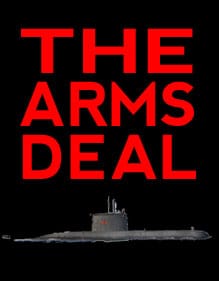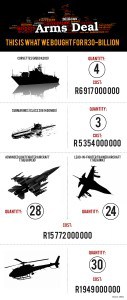|
Getting your Trinity Audio player ready...
|
 The total amount of public money involved was US$4.8-billion, or R30-billion at the exchange rate of the day.
The total amount of public money involved was US$4.8-billion, or R30-billion at the exchange rate of the day.
However, this figure does not take into account the costs of financing the deal, which, when added in, bring the total to around R70-billion.
The acquisitions were meant to modernise the South African National Defence Force’s existing equipment, and it followed from the White Paper on National Defence, approved in 1996 by Cabinet. This document outlined the country’s new defence policy and encompassed “countering military threats; the orientation, preparation, maintenance and employment of armed forces; and the procurement of weaponry and military equipment”
The hardware was to be purchased from a number of foreign dealers and it included naval craft, submarines, fighter aircraft, helicopters and other equipment. Attached to the procurement of military equipment were requirements for bid winners to invest in South Africa by building factories in South Africa to help alleviate unemployment, and to source certain items locally.
The Department of Defence, through its procurement division Armaments Corporation (Armscor), would acquire the equipment. Armscor has since testified before the Seriti Commission that it was not involved in arms deal procurement.
In November 1998, Cabinet announced its preferred suppliers for the procurement of defence equipment for the SANDF – they included companies from Germany, Sweden, Britain and Italy.
Among them was British Aerospace (BAe), which was to deliver 24 Hawk 100 lead-in fighter trainers and 26 Jas 39 Gripen advanced light fighters to the South African Air Force. Altogether these would cost just short of R16-billion.
The German Frigate Consortium and the German Submarine Consortium would supply three Class 209 Type 1400 MOD diesel-electric submarines and four Meko A200SAN corvettes at a price of just over R12-billion.
Agusta of Italy would supply 30 light utility helicopters, the 109 LUH model, for just under R2-billion.
The corvettes have since been reclassified as frigates.
“The cost of the equipment package is R21.3 billion over the next 8 years,” stated the government’s announcement. “If the option to procure additional equipment is exercised, the total equipment cost will rise by R8.5 billion to R29.9 billion over 12 years. The options must be exercised by not later than the year 2004.”
The equipment
The multi-purpose Meko A200SAN patrol corvettes were intended to replace the current strike craft, which were more than 30 years old. They would be acquired from the German Corvette Consortium consisting of Blohm + Voss, Thyssen Rheinstahl, Howaldtswerke Deutsche Werf and France’s Thomson CSF. The craft would be used in various naval missions, such as combat exercises, search and rescue missions, or sea patrols. The combat suite element, which made up about 40% of the cost, would be fitted in South Africa after delivery.
The twin-engine Agusta A109 LUH helicopters would replace the SAAF’s 40+-year-old French Alouette III helicopters. Their operating costs were expected to be lower than the Alouettes. Each could accommodate up to eight occupants, including the pilot and co-pilot, and could also be configured to hold two stretcher in times of emergency. They would be used for training, emergency services, patrols, SAPS support, and search and rescue in internal security, border patrol and peacekeeping operations.
The three Class 209 Type 1400 MOD diesel-electric submarines would replace the navy’s Daphnes, which were more than 30 years old and were hard to maintain. They would be purchased from the German Submarine Consortium, comprising Thyssen Nordtsee Werke, Howaldtswerke Deutsche Werf, and Ferrostaal. The submarines would be used in peacekeeping operations, as a deterrence for potential aggressors, to patrol the waters around the coast, and to collect various types of intelligence.
The British Aerospace Hawk 100 fighter trainers would replace the Impala trainers, which had been declared obsolete by the SAAF. They would provide the bridge between the first element of the training tier, the Pilatus turbo-prop trainer and the third element of the tier, the Cheetah C. They would be customised for South African conditions and requirements. The dual-seaters could be used for jet training and for weapon delivery training, as well as border patrol, search and rescue, reconnaissance, and other functions.
The Jas 39 Gripen fighter aircraft, of which both single- and dual-seater variations had been ordered, would replace the SAAF’s dual-seat Cheetah D and the single-seat Cheetah C fighters. It was state-of-the-art at the time, and would be used for top-tier training, land and naval fire support, reconnaissance, and counter operations and interception, among other functions.
Selection process flawed?
Losing bidders complained right from the start that their bids – in some cases cheaper than the winning bid – were overlooked.
A Business Day article from 1998 reports that Miguel Martinex of the Spanish shipbuilding company Bazan was one of those outraged by the decision. Martinex said: “What we cannot understand is that our price tag was 25% less than the offer by the German Frigate Consortium for the patrol corvettes – the price from them is R6-billion as against our R4.2-billion for what we believe is a superior and tried and tested ship. For a country which says it is struggling for every penny, we find this to be an unbelievable decision.”
A representative of Bell Canada, which had bid for the helicopter contract and lost to Agusta, said that the decision appeared to be politically motivated.




